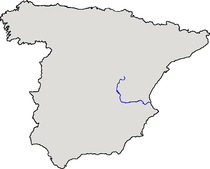


The Júcar (Spanish: [ˈxukaɾ] ) or Xúquer (Valencian: [ˈʃukeɾ]) is a river in Spain, on the Iberian Peninsula. The river runs for approximately 509 km from its source at Ojuelos de Valdeminguete, on the eastern flank of the Montes Universales in the Sistema Ibérico. Its most important tributary is the Cabriel.
The Júcar River flows first southward and then eastward through the towns of Cuenca, Alcalá del Júcar, Cofrentes, Alzira, Sueca, Alarcón and Cullera, a town located near its mouth into the Gulf of Valencia in the Mediterranean Sea. It crosses the provinces of Cuenca, Albacete and Valencia.
In 1982, the river Júcar broke the Tous Dam, causing the biggest flood in Spanish history, with a flow speed of 16,000 cubic metres per second, killing more than 30 people. This flood was the most important one in the whole history of Spain because, at that time, the people had thought that the Tous Dam was indestructible. The flood was called La pantanada de Tous.
See also
[edit]References
[edit]External links
[edit]- Confederació Hidrogràfica del Xúquer
- Plataforma Xúquer Viu
- Projecte de seguiment de la qualitat del Xúquer
39°10′22.28″N 0°17′41.07″W / 39.1728556°N 0.2947417°W
Well, that’s interesting to know that Psilotum nudum are known as whisk ferns. Psilotum nudum is the commoner species of the two. While the P. flaccidum is a rare species and is found in the tropical islands. Both the species are usually epiphytic in habit and grow upon tree ferns. These species may also be terrestrial and grow in humus or in the crevices of the rocks.
View the detailed Guide of Psilotum nudum: Detailed Study Of Psilotum Nudum (Whisk Fern), Classification, Anatomy, Reproduction